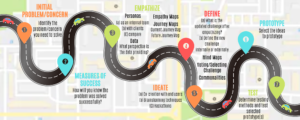Ideate is the third step in the design thinking process. It occurs after define, in which you have identified the challenge that you are looking to solve as a clear problem statement. At ideate, you are ready to come up with creative solutions to the problem. The ideate phase is an exciting part of the design thinking process where there is no holding back – no idea is off the table – the sky is the limit!
Ideation sessions consist of one or more brainstorming sessions (s) with team members, users, or other stakeholders. Preparation is crucial to organize an ideation session or workshop. Break out the sticky notes, pens, markers, and other materials participants might use to convey ideas in a written or graphic format. Use icebreaker activities to warm up the group and relieve any tension – participants need to feel comfortable and relaxed to share ideas freely. You can host the ideation session outside your everyday work environment or even host them virtually. A different environment provides new stimuli and can encourage outside-of-the-box thinking. It is also vital to prevent hierarchy from affecting the group. For example, if there will be mixed working levels of participants within the organization, all ideas must be presented equally.
The goal of an ideation session is to generate as many ideas as possible. Think quantity over quality during the initial wave of ideation. You might get a TON of ideas. The following tips will ensure your session runs smoothly and successfully:
- Set time limits for each part of the session.
- Use and refer back to your agenda during the session to stay on track.
- Start with (and refer back to) your problem statement from the Define Phase.
- Create a space where everyone feels equal and can share freely.
- Encourage participants to be visual (by using drawings, writing on sticky notes, etc.)

The moderator of the ideation session should mitigate any judgment during the session. Allow all participants to question the obvious and challenge overarching beliefs, assumptions, and approaches. Participants should feel welcome to build off each other’s ideas and gather a range of perspectives of the solution, rather than focus on whether the concept itself is plausible or not. Spring2 Innovation teaches several different brainstorming activities you can hold during the workshop, including Challenging Assumptions, Reverse Thinking, and Mind Mapping to guide participants’ thinking and help organize and group ideas. It is important to harness the group’s collective creativity to arrive at as many solutions as possible. However, you must also guide the group effectively.
Once the brainstorming is completed, all of the great ideas from the session must be narrowed down. Have all of the ideas visible and allow the group to vote on the best ideas. The criteria for selecting the best ideas depend on the specific challenge you are looking to solve. Remember that these top ideas that you choose from the ideation phase provide essential fuel for the Prototyping phase that follows.
For more information on the Ideation phase, check out Spring2 Innovation’s YouTube channel:
As part of Spring2 Innovation’s Design Thinking Certificate, we teach you how to master all five phases of the Design Thinking methodology, starting with the empathize phase. We teach learners how to create effective personas and conduct other types of user research before beginning a new design (or re-design) of a product or service that involves end-users.
Master all five phases of Design Thinking. Click here to enroll in our Design Thinking Certificate program today!

